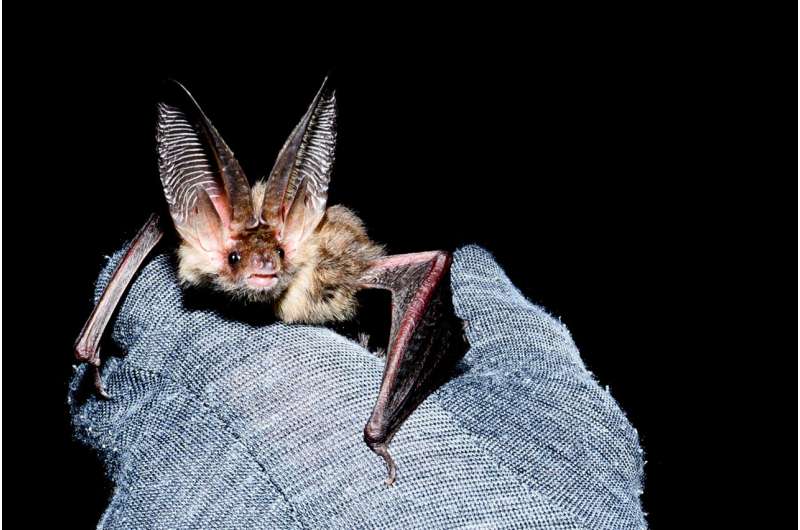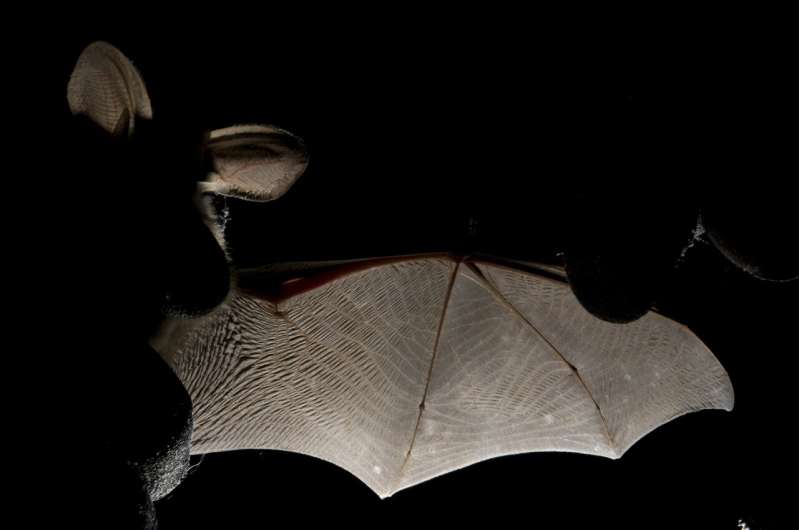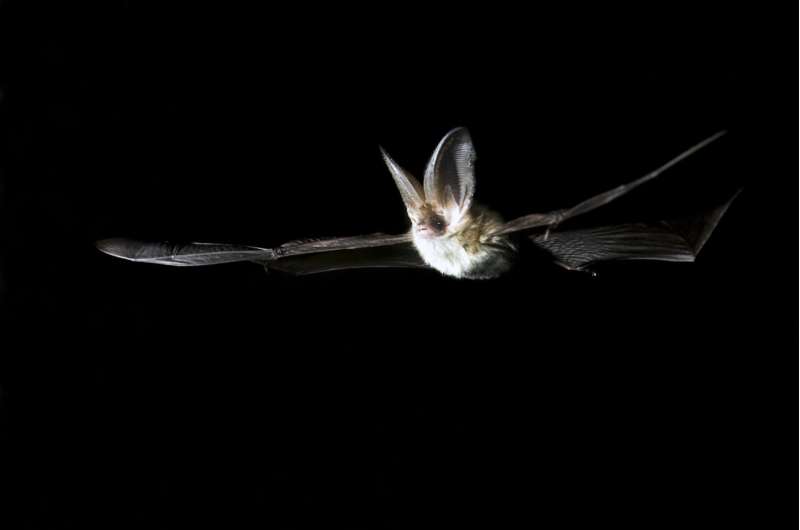This article has been reviewed according to Science X's editorial process and policies. Editors have highlighted the following attributes while ensuring the content's credibility:
fact-checked
trusted source
proofread
How bats survive Norwegian winter nights

You have probably seen bats flying at dusk. They suddenly appear on summer evenings, when other flying creatures have settled down for the night. However, they are not a common sight in Norway, because there aren't that many of them. In addition, bats are not so easy to spot, seeing as they only emerge from their hiding places once darkness descends.
Animals have many characteristics that we can learn and gain knowledge from, and one example is echolocation, which bats have used for over 50 million years to navigate in the dark. Bats emit sounds at ultrasonic frequencies that humans are unable to hear, and they navigate by using the echoes they pick up from these sounds. Ultrasound was discovered in part through studies involving bats.
There are 1,439 known species of bat in the world. The smallest weigh just 2 grams, and the largest weigh 1.5 kilograms and have a wingspan of 1.5 meters. Bats are the only mammal that can fly, and some species of free-tailed bats can fly at speeds of up to 100 km per hour.
This diverse creature is found almost everywhere in the world and constitutes 20 percent of all mammal species. Most species of bat are found around the equator, and two areas are particularly rich in bats: the Amazon and the islands between Asia and Australia. The further north and south you go, the fewer species there are.
How do they survive the cold winters in Norway?
Seventy percent of bat species feed on insects, but some species feed mainly on plants, and others eat small animals such as frogs, mice and lizards.
This means that the availability of food varies with the seasons. For those species that live in cold regions with long winters (like Norway), there is little access to food for many months. As a result, bats that live in cold regions go into a kind of torpor to save energy.
Little is known about how the species that live in Norway hibernate, nor do we know much about where they go in winter. In many other countries, there are large, natural caves in which thousands of bats take shelter. In Norway, they probably live in rock crevices, but the number of bats that do this is unknown.
Eleven different types of bat are found in Norway, all of which belong to the Vespertilionidae family of bats, more commonly known as "evening bats" or "vesper bats". All 11 species are protected and 6 are red-listed, including the world's northernmost species called the northern bat (Eptesicus nilssonii).
Hardly any research on Norwegian bats
In his doctoral thesis, biologist Rune Sørås has studied what happens to northern bats when they hibernate.
"I have researched how bats manage to survive in Norway by lowering their body temperature and reducing their energy expenditure when exposed to cold temperatures. Hardly any research has been conducted on bats in Norway, so we have helped create a new phase in bat research. In addition, bats have had fairly low status in nature management, although they have now received a little more attention due to the development of wind turbines," says Rune Sørås.
Much of the work involved in studying bats is often run by volunteers.
The Norwegian Zoological Society is an organization concerned with all groups of animals, and they gather information about bats and actively study them. The Norwegian Zoological Society website provides information about what to do if you find an injured bat. Norway is also a member of EuroBats, an organization and system of agreements for European countries that commit to taking care of their bat species.
What is the function of bats?
Bats have existed for over 50 million years and are masters at adapting to their environments. However, in many places, bats are threatened by developments taking place in their habitats, and because the insects that most bats live on are disappearing due to pesticides and pollution. Another factor is that the environments where bats live are affected by climate change.
"The reason why it is important to study bats is that they play an important role in ecosystems. For example, they can help reduce damage to food crops because they eat insects that reduce crop yields," says Sørås.
The fact that bats eat insect pests means that less pesticide is needed. A small bat can eat up to 1,000 insects a day, including everything from moths to mosquitoes that can carry infectious diseases such as malaria, dengue fever and yellow fever.
This is called an ecosystem service. Bats also provide other ecosystem services, such as seed dispersal.
"By better understanding how bats function and live, we can better predict, manage and protect them," says Sørås.

Bat hibernation is demanding
Many of the specimens Sørås has used in his research were captured in Nittedal, Trondheim and Orkland in Trøndelag. In Orkland, Sørås found approximately 100 Brandt's bats living in a small log cabin.
The 44 bats he examined were released unharmed after he had measured the metabolism of each individual. Metabolism is the chemical process in the body that converts oxygen, food and other materials into substances that the body needs in order to function.
Sørås has studied the temperatures at which bats start to hibernate, how much energy they use in connection with hibernation and how they use the energy.
"Understanding how bats manage their own energy budget under different climatic conditions is an important component in understanding what limits their prevalence and their ability to withstand environmental changes, such as climate change," says Sørås.
Bat hibernation is rather peculiar and quite demanding for the animals. When they hibernate, their breathing slows down, but they do not go to sleep. They need to drink, defecate and maybe sleep a little on a regular basis. In other words, they alternate between hibernation and necessary activity, but one challenge during hibernation is actually sleep deprivation.
They have two types of hibernation, a short-term hibernation called torpor that lasts less than a day; and a long-term hibernation that lasts over a day. Some bats only go into short-term hibernation, while others can do both.
"However, there is a lot we don't know about what happens when bats are in a state of hibernation, so we wanted to find out more about it," Sørås explains.

Thin individuals hibernate quicker than fat ones
Sørås and his colleagues started out with a theory that bats will not be able to tolerate the changes in temperature that climate change is likely to bring.
"We found that thin specimens went into hibernation quicker than those that were fat, and well-fed bats were active longer and waited longer before hibernating. Fatter bats also came out of hibernation earlier than the thinner ones. In other words, the length of hibernation depends on what kind of shape bats are in. Our studies show that bats are more adaptable than we originally assumed. They have a flexible and opportunistic metabolism that enables them to adapt to a wider climate spectrum than we first thought," says Sørås.
The study provides insight into the physiological flexibility of bats living at high latitudes in the Northern Hemisphere. Thanks to their flexible and adapted use of hibernation and torpor to manage their energy budgets, bats can withstand long periods of limited food supply.
"On a global scale, the energy expenditure of bats has largely been overlooked. So far, research has been limited to a few species, often focused around small geographical areas. In order to better predict, manage and protect species affected by climate change, more work is therefore needed to understand the physiological and behavioral responses of bats to different environmental conditions," says Sørås.
Wing prints
One of the peculiarities of bats that most fascinates Sørås is that they all have their own unique pattern on the skin of their wings. One could say that the wing prints of bats correspond to human fingerprints. While human fingerprints often have to go through police data analysis to be recognized, the patterns found on bats' wings are easily visible and recognizable to the naked eye, making it relatively easy to identify individuals.
When Sørås caught specimens for research, many of them were immediately released back into the wild, such as pregnant females. "There was actually one bat that I caught 8 times, and it was easily recognizable from its wing prints," says Sørås.
Bat ringing, which is done in quite a few countries, can easily damage the skin of bats' wings and affect their ability to fly. "Bat ringing is a major topic of discussion in international bat research," says Sørås.
This topic is on the program for the next publication, and Sørås is working on an idea to use artificial intelligence to identify individual bats from their wing prints.
More information: PhD dissertation: Energy management of heterothermic bats at northern latitudes: Understanding the physiological flexibility of bats and how this enables them to live in the northern edge of their distribution
Provided by Norwegian University of Science and Technology


















